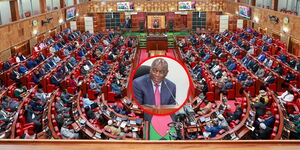The Directorate of Criminal Investigations (DCI) on Friday, April 25, announced the arrest of a phone thief behind a notorious phone theft syndicate in Naivasha.
Through a statement, DCI revealed that the suspect was caught red-handed as he was flashing his latest collection of stolen mobile phones. During the raid, detectives disclosed the recovery of 27 stolen phones, a laptop and the mobile flashing kit.
“Naivasha detectives have apprehended a notorious figure in the illegal trade of stolen mobile phones,” DCI stated.
“Acting on reliable intelligence, a team of detectives raided his shop located at the Sera Centre Building in Naivasha town. They caught him red-handed, flashing a collection of stolen mobile phones,” they added.
Typically, a mobile flashing kit is used to install or reinstall the firmware (operating system) of a mobile phone. This process is called "flashing." It is also used in fixing software issues where it resolves issues like boot loops, lagging, virus infections, or system crashes.
However, the kit can be misused to bypass security locks, erase owner data, remove factory reset protection, change a phone’s International Mobile Equipment Identity (IMEI) number and prepare stolen phones for resale.
Thieves use flashing tools to remove screen locks, such as PINs or patterns, allowing them to access and resell the phone. Flashing wipes all data, including contacts, photos, and the owner's account, making the phone appear new and untraceable.
Some advanced tools can change a phone’s IMEI number—its unique ID—making it harder to trace. This is illegal in many countries. After flashing, stolen phones are often sold in second-hand markets as “clean” or “refurbished.”
The practice of phone flashing has especially escalated in Kenya, particularly with the rise of Buy Now, Pay Later (BNPL) smartphone financing models. This trend is notably prevalent in urban centers such as Nairobi, Eldoret, Kisii, and Kitale, where coordinated operations have been identified.
For instance, in just two months (July to September 2023), the BNPL industry reported losses exceeding Ksh100 million due to phone flashing activities. Entry-level smartphones are particularly targeted because of their affordability and high demand in both local and neighboring markets.
In Kenya, engaging in unauthorized mobile phone flashing—such as tampering with a device’s software to bypass security features or altering its IMEI number—is a criminal offense under several laws.
Under the Computer Misuse and Cybercrimes Act, 2018, unauthorized flashing attracts a fine not exceeding Ksh5 million, imprisonment for a term not exceeding two years, or both. For more severe offenses, such as unauthorized interference with critical information infrastructure, the penalties can escalate to a fine not exceeding Ksh10 million, imprisonment for a term not exceeding five years, or both.
Under the Penal Code, offenses like forgery, fraud, and handling stolen property are addressed. While specific penalties for IMEI tampering are not explicitly detailed, related offenses can attract imprisonment for up to seven years, depending on the nature and severity of the offense.












